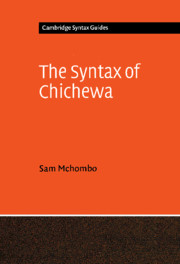Book contents
- Frontmatter
- Contents
- Acknowledgments
- List of abbreviations
- 1 Introduction
- 2 Phonetics and phonology
- 3 Clause structure
- 4 Relative clauses, clefts, and question formation
- 5 Argument structure and verb-stem morphology
- 6 Argument-structure-reducing suffixes
- 7 The verb stem as a domain of linguistic processes
- References
- Index
4 - Relative clauses, clefts, and question formation
Published online by Cambridge University Press: 08 October 2009
- Frontmatter
- Contents
- Acknowledgments
- List of abbreviations
- 1 Introduction
- 2 Phonetics and phonology
- 3 Clause structure
- 4 Relative clauses, clefts, and question formation
- 5 Argument structure and verb-stem morphology
- 6 Argument-structure-reducing suffixes
- 7 The verb stem as a domain of linguistic processes
- References
- Index
Summary
Relative-clause formation
The discussion in the preceding chapter concentrated on verbal complementation with some remarks on the structure of the noun phrase. The noun phrase also provides instances of complementation with a nominal head. It has been indicated that within the noun phrase modifiers of the head noun are marked for agreement with that noun, in number and gender. In this chapter attention will turn to the relative clause. The relative clause provides the easiest form of clausal complementation to a nominal head. It also gives variations that are of intrinsic interest to theoretical discussion (cf. Biloa 1990; Chomsky 1977; Keach 1980; Ngonyani 1998b). However, before focusing on the relative construction, comment should be made on non-relative complements. These would be of the variety exemplified in English by expressions such as ‘the belief that it would rain.’ In Chichewa such complementation is achieved by the use of the verb tí ‘say’ in its infinitive form kutí ‘that,’ linked to the head noun by the associative marker -á. For most speakers the sequence á+ kutî is reduced to otí. Ordinarily, the coalescence of the associative marker á with the infinitive marker ku to o is sensitive to the syllable structure of the ensuing verb. It is possible when the verb is not monosyllabic. This is one of the cases when the sensitivity to syllable structure is over-ridden, generally characteristic of some dialects of Chichewa, such as the dialect described by Mark Hanna Watkins (1937).
- Type
- Chapter
- Information
- The Syntax of Chichewa , pp. 39 - 62Publisher: Cambridge University PressPrint publication year: 2004

